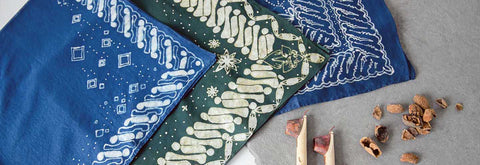Of the many batik styles and stories embedded in each motif, none is known more for its illustriousness and prestige than Parang.

Recognizable through its s-shaped design, batik Parang was once only to be worn by those who had royal bloodline in the Yogyakarta region during the Majapahit empire. Directly translated from “pereng” which means "cliff" or “slope,” the wavy designs illustrate waves breaking against the rock face, symbolizing the perseverance and strength of good character in the face of hardship.
Though this batik motif is worn outside the royal courts today, it still carries the reputation and cosmic wisdom embedded in its design. Here are some types of batik parang and the symbolism and stories behind them:
Parang Rusak

Tracing back to the 17th-century, Panembahan Senopati, known to be the last descendant to the king of the Majapahit empire, saw visions of the wave-like design through meditation.
“Rusak” translates to “ruined” and signifies the brute force the cliff can withstand despite the constant crashing waves. Those who wear this motif carry with them a courageous spiritedness that never tires. It is even said that batik Parang Rusak would be worn by soldiers at the end of a battle to inform the king of victory.
Check out the Parang Rusak motif in the colour hijau from The Batik Library's Parang Collection, a selection of hand-dyed bandanas made with communal care in the Kemlagi village of Mojokerto.
Parang Curigo

“Curigo” is another word for the traditional keris dagger in Javanese. These intricately carved traditional blades—often crafted from rare metals and meteorites—carry spiritual significance, are passed down as heirlooms and are a symbol of status similar to the batik Parang itself.
The sharpness of the dagger referenced in batik Curigo, represents the sharpness of mind. Those in possession of a keris or curigo were known to be able to use it as a talisman to carry potent powers and wisdom to pass down to future generations.
Check out the sharpness of the Parang Curigo motif in the colour biru from The Batik Library's Parang Collection, a selection of hand-dyed bandanas made with communal care in the Kemlagi village of Mojokerto.
Parang Klitik

Parang Klitik showcases smaller and simpler s-shaped patterns and symbolizes tenderness and wisdom. Parang Klitik was a motif worn by the queens and princesses in the royal palace, as it was known to be a choice fit for those of smaller stature.
Creating one-of-a-kind pieces suitable for all genders and identities is part of The Batik Library's core vision in making the story of batik accessible.
Check out The Batik Library's complete gender-neutral collection including this sleeveless shirt in the colour hijau.




